Red Deer Behaviour & Social Structure
Red deer are gregarious mammals, often associating in family groups. Early work looking at the social systems and group structures of Red deer (during the late 1930s through until the mid-1970s) yielded mixed results; some have pointed to fairly stable (principally familial) groups, while others have suggested that any ‘ties’ are irregular and group membership fluctuates on a daily basis. More recent studies on this species in almost all conditions (island populations, mainland populations, captive animals etc.) have started to clarify the situation and it’s painting a fascinating picture.
We now know that Red deer have a highly flexible social system that varies according to the habitat and time of year, as well as the age and sex of the animals involved. That which follows is a summary, but the reader is directed to the excellent 1982 book Red Deer: Behaviour and Ecology of Two Sexes, by RDRG biologists Tim Clutton-Brock, Fiona Guinness and Steve Albon. The book is fairly old now but still provides a fascinating and in-depth grounding in Red deer sociality on Rum.
His and Hers? Sexual Segregation in Red Deer
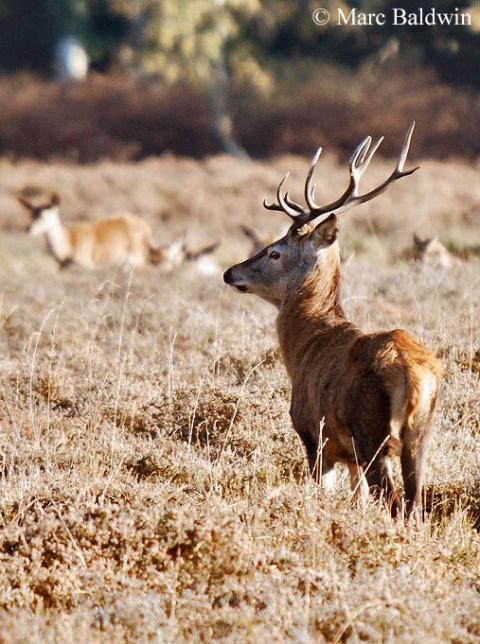
There is a distinct sexual segregation among Red deer that appears to vary geographically; almost all stags on Rum, for example, can be found in so-called ‘bachelor groups’, while studies on Crimean Red deer have shown that only 20% to 30% of stags are likely to be found in bachelor groups. Some researchers have observed that sexual segregation breaks down when artificial feeding stations are provided, although this doesn’t seem to be the case for all populations. The data from Rum have shown that, although stags may be seen in groups of females, it is generally rare for stags more than three-years-old to associate with hind groups.
In their 1982 book, the RDRG biologists note that most of their hinds spent between 80% and 90% of their time in groups without stags older than three years and only 10% to 20% of mature stags associated with hinds outside the rut. The exception seems to be if the stag is castrated; research from Rum has shown that orchiectomized (another word for castrated, from the Greek orkhis, meaning ‘testicle’) stags associate more closely with their dams -- adopting a core range coinciding with that of hers -- than ‘intact’ stags. The RDRG have found that there is an obvious close bond between the dam and calf during its first year, which tends to degrade as the hind approaches her next oestrous – it appears that this initial level of mother-calf ‘closeness’ is never regained, although if the mother is barren in the following year, the relationship with her most recent calf may continue for longer.
Overall, while the frequency with which sons and daughters associate with their mother (and/or her group) tends to wax and wane as they get older, they’re generally seen in their mother’s party less often as they approach maturity, although daughters typically associate more closely with their mothers than sons do.
Factors influencing segregation
Before looking at the stag and hind groups more closely, it is worth considering why we see sexual segregation in this species. Several theories have been put forward to try and explain these groupings; the two that seem to have amassed the most support are the ‘feeding dichotomy’ (or ‘indirect competition’ hypothesis) and ‘weather sensitivity’ hypotheses. The first of these, as discussed by Clutton-Brock and his co-authors in their 1982 book, points out that the extent to which stags associate with hinds declines at between three and five-years-old, which corresponds to changes in feeding behaviour, where stags consume more heather while the hinds feed predominantly on grasses. Why should this be? After all, rumen content analysis has found that there is little, if any, significant difference between the diets of the stags and hinds during the summer months; why should this change during the winter?
Clutton-Brock and his co-workers suggested that the hinds may out-compete the stags for the short greens (i.e. flushed grassland). The theory goes that because stags have higher energetic demands, they need more food and, in areas that are heavily used by hinds, the standing crop of the short greens is too low to satisfy their needs and they’re forced on to the heather moorland where the standing crop biomass is higher. In other words, the heather may be of poorer nutritional value than the grass, but there’s more of it so the stags use less energy trying to get enough of it. This theory is supported by the observations that the degree of segregation varies according to the plant community the deer have access to and is more pronounced in places where (or during seasons when) food is scarce. However, more recent data have cast doubt on this hypothesis.
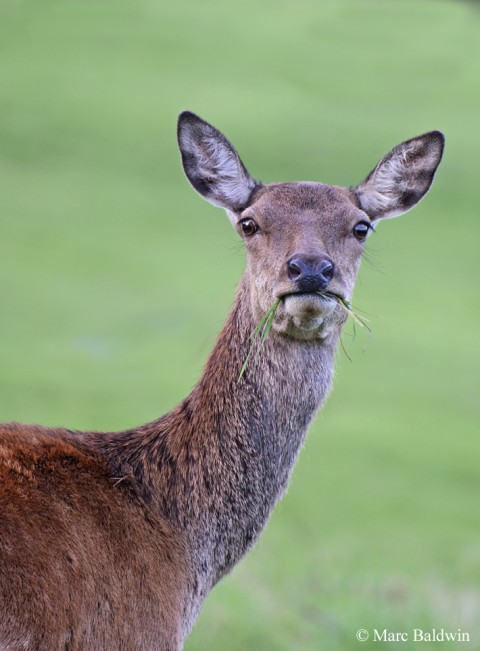
In a paper to the journal Oecologia during 1999, Larissa Conradt, Tim Clutton-Brock and Derek Thomson present their findings on the habitat segregation in Rum’s deer. The biologists found that even when they reduced the number of hinds on the greens, the males didn’t start using them in favour of the heather, which you’d expect if the females were responsible for the males moving to lower quality feeding sites. The Jarman-Bell Principle, which suggests that small grazers are more efficient at grazing short swards (their small-mouthed bite profile allows them to be more selective and, in theory, crop vegetation more closely) while larger grazers are forced to areas of poorer quality habitat, is well established among mammals; but the authors suggest that the sexual dimorphism between stags and hinds is insufficient for this principle to apply to Red deer. In other words, stags aren’t that much bigger than hinds that the hinds could out-compete the stags for areas of prime grazing. The authors concluded that:
“... the indirect-competition hypothesis does not explain sex differences in habitat use in red deer on Isle of Rum.”
So, if it’s not the female’s grazing ‘technique’ that prevents the stags from using the greens during the winter, what is it? Conradt and her team don’t propose an alternative explanation in the aforementioned paper, but there is another theory that has gained support.
In 1973, as part of a Master of Philosophy degree at the University of Edinburgh, Anne Jackes studied the use of wintering grounds by Red deer in Ross-shire, Scotland. Jackes observed that adult stags appeared to opt for shelter over food; they sacrificed the better quality foraging grounds (which tended to be more exposed to the elements) for areas of lower quality food but better shelter – this is known as the “weather sensitivity hypothesis”.
A few years later Brian Staines found that wind direction, and more importantly wind chill, affected the distribution of the deer at Glen Dye in North-east Scotland. Staines observed that some, more exposed, feeding sites were used less during bad weather, with deer opting to graze in more sheltered areas even though the food may be of better quality on the exposed patches. Thus, on windy days, it seems probable that the choice of feeding sites is more limited than it is during calm weather.
More recently, Conradt, Clutton-Brock and Guinness set out to test the weather sensitivity hypothesis as an explanation for the sexual segregation of deer on Rum. Conradt and her colleagues conducted regular censuses of the deer on the North Block of Rum between 1974 and 1993 and found that while both hinds and stags reduced their use of high quality, but exposed, habitats during bad weather, males were more sensitive to strong winds and low temperatures than females and fed more at sheltered sites on windy days than hinds. Writing in their paper to the journal Animal Behaviour in 2000, the biologists concede that there probably isn’t a single, universally acceptable explanation to explain sexual segregation among ungulates:
“… it is unlikely that a single explanation applies to the widespread phenomenon of intersexual habitat segregation, and different explanations will have to be sought for different species under different ecological conditions.”
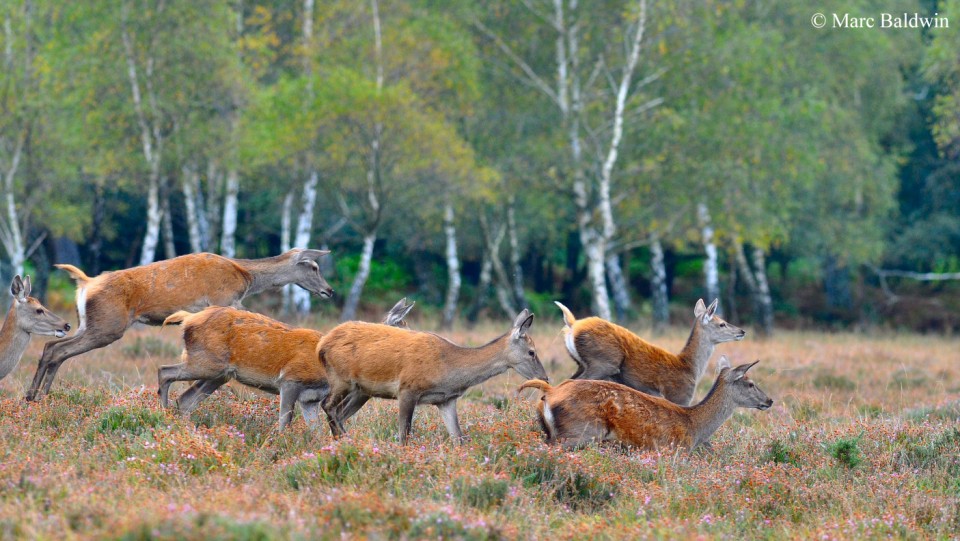
So, the jury is still out as to why the sexes split up during the winter, but it seems likely that, on Rum at least, the stag’s greater sensitivity to adverse weather conditions may be a major factor. We may not yet see the full picture of sexual segregation, but the question of why deer group in the first place is more straightforward to answer, and there are two primary theories. Grouping may represent an anti-predator mechanism and the RDRG biologists note that deer in small groups are ‘jumpier’ than those feeding in larger groups – large groups have more eyes to spot a potential predator and more bodies that a predator could choose, meaning the odds of it being you is reduced as group size increases.
Deer may also group as a response to biting flies for a similar reason: more deer means fewer flies per animal. Deer biologists tend to argue that relief from biting flies is unlikely to be the main reason for deer grouping together, but it is interesting to note that, on Rum, group size shows a tendency to increase on days when biting fly activity is high. Whatever the reason(s) for grouping, it is a common feature among this species throughout much of its range. The number of animals seen in groups depends on the habitat (smaller groups form where resources are patchily distributed) and weather conditions (small groups seek out sheltered ground during bad weather) – the range is anywhere from four animals to in excess of one hundred.
Most studies suggest that group size tends to increase as the day wears on, with larger groups seen in the late afternoon and evening. Deer living in ‘closed’ habitats (e.g. forests) typically form smaller groups than those living in ‘open’ areas (e.g. moorland or greens); this is presumably a combination of the distribution of resources (food, water, shelter etc.) and the physical space available for congregations.
Stag Groups
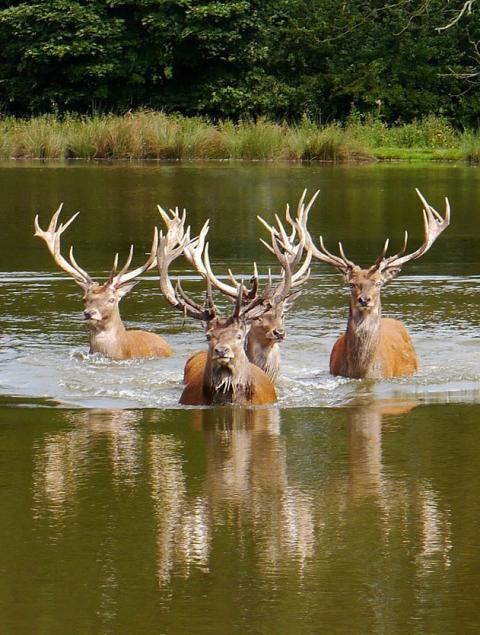
The detailed studies on Rum’s deer population by the RDRG have shown that the relationship between a stag calf and its mother deteriorates rapidly as the summer wears on, such that the calf is typically only seen with its mother about 20% of the time as the rut approaches. The calf appears to receive more threats from its relatives during its second year and there is a noticeable increase in the calf’s range size in its third year, as it begins associating more with other stags than the hinds it grew up with. In their 1982 book, Clutton-Brock and his colleagues recall that about 30% of the stags had moved out of their study population by the time they were five-years-old; this was roughly balanced by stags immigrating from other populations such that about 25% of the six- and seven-year-old stags resident in the population were immigrants. The biologists also point out that although dispersal distances on Rum are generally small (owing to the size of the island), a report for the Red Deer Commission (now the Deer Commission for Scotland) in 1978 found that 70% of stags tagged on the mainland were recovered more than two kilometres from their birth place – the record was one that travelled 22 km (15 miles).
Deer are good swimmers and crossing channels between near shore islands and the mainland doesn’t present a significant barrier to dispersal, although genetic work by biologists at the University of Edinburgh suggest that in some Highland populations sea lochs, mountain slopes, roads and dense forests can be barriers to dispersal – the data indicate that inland lochs, rivers and railways promote dispersal.
Data, from Snillfjord in Norway, have shown that dispersal distance is understandably related to population density, with stags moving more than 10 km (7 mi.) further away from high density populations than low density ones – the average distances were 37 km (25 mi.) and 26 km (17.5 mi.), respectively, with the greatest distance recorded being 147 km (99 mi.). Red deer can also display quite a turn of speed and, according to Norma Chapman in her 1991 book Deer, one escaped Red stag was clocked by a police radar trap doing 42 mph (68 kmph) down a street in Stalybridge, Cheshire during October 1970.
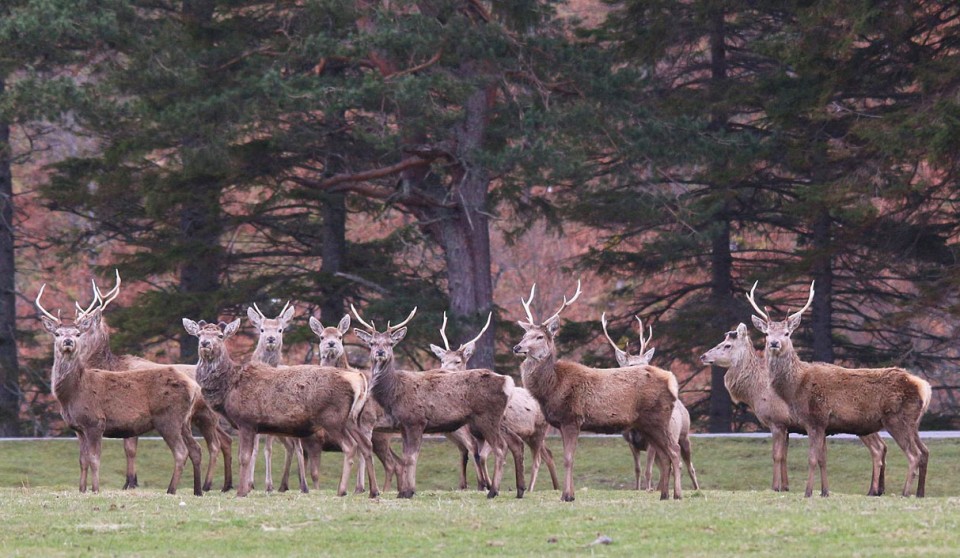
Whether stags end up dispersing a few kilometres, or several tens or hundreds of kilometres, they begin exploring at about six months. Work on Rum shows that stag calves are generally tolerated by harem-holding males until they’re about 18 months old, at which point the breeding male will usually chase them out of the group, although they commonly return after the rut and remain with their mother until the following rut.
In their contribution to the Mammals of the British Isles: Handbook, 4th Edition, Brian Staines, Jochen Langbein and Tim Burkitt mention that stags leave their mothers at between one year (in plantations) and two years old (on open ground), or are chased away when the rut begins or a new calf is born. Staines and his co-authors also note that stags may wander widely, failing to settle for several years, when they establish their seasonal ranges and often associate with other stags. Stag groups typically consist of individuals of the same age, although mixed-age groups have been documented, with old stags generally seen alone. On Rum, observations suggest that males typically join stag groups in areas close to those used by the hinds, at between two and three years of age.
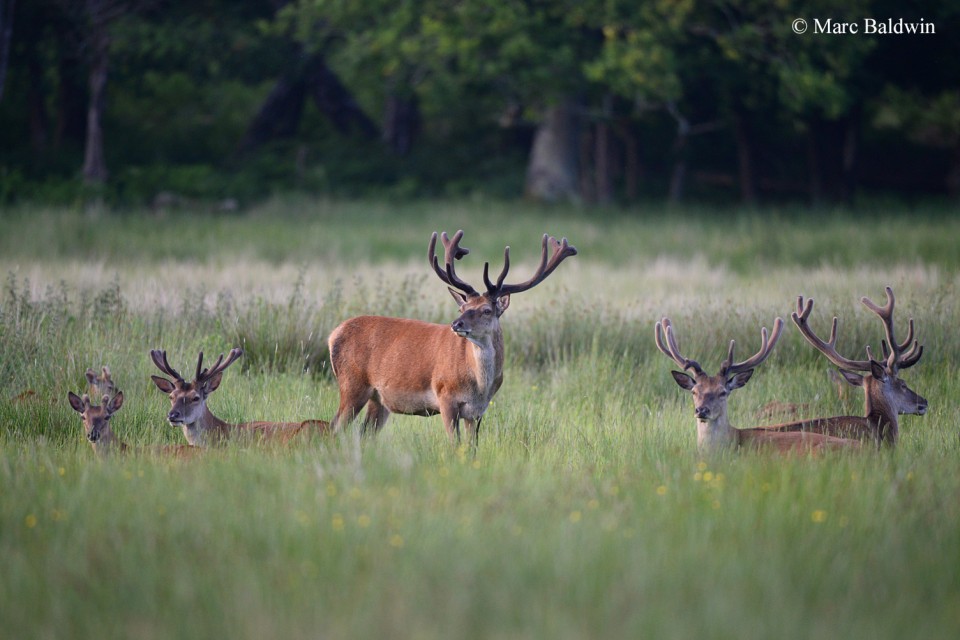
There is no evidence that stags preferentially associate with (or indeed even recognise) male siblings and the groups are usually loose (i.e. less stable than those of hinds); the RDRG have documented how stags in these bachelor parties change core areas, leave and join groups regularly. Indeed, in their 1982 book, Clutton-Brock and his co-authors wrote:
“The membership of stag parties changed from hour to hour as individuals joined or left. Relationships between parties were relaxed, and we did not observe either aggressive interactions between parties or cases where one party displaced another.”
The authors also note that, among animals more than four-years-old on Rum, the median (i.e. middle) group size of stags in the summer months was seven individuals, declining to groups of four during the winter. In his 1967 A Field Guide to the Mammals of Britain and Europe, Frederik Hendrik van den Brink notes that old, non-pregnant or infertile hinds are sometimes found in these bachelor groups. Stag groups have a hierarchical structure that seems more linear than that of hind groups (i.e. there are fewer cases of low-ranking animals dominating higher-ranking ones in stag groups) and dominance relationships seem to be relatively consistent year-on-year. The factors affecting the placement of an individual in the hierarchy are complicated and poorly understood.
Antler casting and social status
While stags retain their antlers, the ‘pecking order’ -- so named, incidentally, because it was first described in chickens by the Norwegian zoologist Thorleif Schjelderup-Ebbe in 1921 -- is largely based upon body size, although once the stags have cast their antlers this situation changes. The stags will each lose their antlers at different times associated with their place in the hierarchy – the higher the rank, the earlier they cast, re-grow and clean their antlers. The reason for this association appears to be related to access to food and studies by Cambridge University zoologist Michael Appleby has shown that higher-ranking stags excluded lower-ranking animals from the experimental feeding plots he setup on Rum. Appleby suggested that holding a high rank might allow a stag to improve body condition by turfing lower-ranking stags out of prime feeding spots; this ‘displacement’ was more common during the winter when food is at its scarcest; peaking in March, when food was at a minimum.
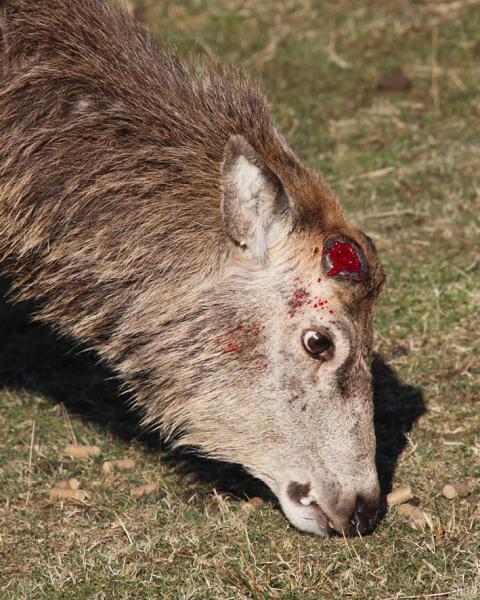
Given that several studies have linked antler casting dates to the nutritional state of the stag, it is not difficult to see how holding a high rank, and the access to more/better food it conveys, could lead to earlier casting.
Stags will sometimes leave the bachelor group briefly to shed their antlers and, when they return antlerless, they often find themselves at a lower position in the hierarchy. Studies on Rum by Appleby have shown that, even though the hierarchy starts to re-establish once all the antlers have been cast, the linearity of the hierarchy is disrupted until the antlers have been cleaned. While the antlers are growing (and are thus in velvet), disputes are settled by rising up on hind legs and kicking out with forefeet – this is referred to as “boxing”.
Observations on captive deer -- which are maintained in mixed-age groups -- have shown that the stags generally don’t remain in the same social group while they’re in velvet, preferring to associate with individuals of a similar age or rank. Work on the “white red deer” held at Czechoslovakia’s Zehusice Game Reserve by Ludek Bartos and Vaclav Perner has found that the greatest number of stag groups occurred as the cleaning period approached (i.e. there were more, smaller groups), as did the number of solitary stags observed and probably for good reason. Writing in the journal Behaviour in 1985, Bartos and Perner note:
“Increases in the size of a social group caused increased levels of aggression in dominant stags and increased the number of attacks on subordinate stags.”
Once the antlers have been cleaned, by late summer, the stags may engage in sparring matches, which should not be mistaken for dominance challenges. Among the stags, the RDRG biologists observed that displacements -- where one animal walked steadily, in a ‘stiff gait’ towards another, forcing it out of the feeding site -- were the most common threat displays, while dominant stags were also observed to raise their head back (pointing the chin at their opponent), curl their lip up and hiss or grind their teeth.
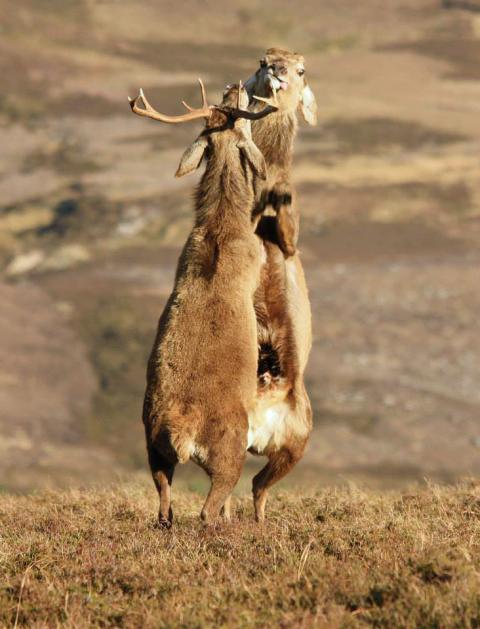
Failure of the opposing stag to back down was met with a nod or shake of the head (I have observed Sika stags, Cervus nippon, to do a similar thing at bystanders or photographers that venture too close), a jab with the antlers or a kick, which if performed with both front legs simultaneously is often referred to as a ‘scissor kick’. Apparently, biting is rare.
The opponent is typically chased away from the immediate area or feeding site, but seldom driven out of the locality. In their 1982 book, the Cambridge University biologists report that although the ‘threat rate’ increases during the winter for both sexes, in a discovery that won’t surprise most of my female readership, males threatened each other about three-times as frequently as hinds threatened each other.
In autumn, the bachelor groups break down and the stags disperse to the rutting stands – there is, incidentally, some evidence to suggest that males holding high ranks in bachelor groups tend to be more successful in the rut and sire more offspring, which is perhaps not a surprise given the increased food benefit that being high in the pecking order seems to convey. Once the rut is over, by late November or early December, the groups reform. Writing in his 1980 paper to the journal Behaviour, Michael Appleby noted that:
“… after the rut, reformation of the group involved fighting in some dyads [pairs of stags], but the hierarchy was then stable again through the winter.”
Hind Groups
Female groups seem more stable than bachelor groups – when the RDRG performed a statistical test called cluster analysis (which, as the name implies, looks at the arrangement of natural groups), they found that the majority of the clusters were small (four, or fewer, animals), matrilineal -- consisting of genetically related hinds -- and stable in composition (i.e. didn’t change year-to-year). In their 1982 book, Clutton-Brock and his co-workers discuss the findings of the cluster analysis study and point out that the core areas of the hind groups overlapped extensively, but rarely coincided perfectly with each other. Overall, the biologists observed that the median hind party size on Rum was seven individuals in summer and five during the winter. As mentioned above, male calves of up to two years old may also join the group.
Cutting the apron strings
Hind groups are typically both matriarchal and matrilineal in nature, meaning that they have a hierarchy where a mother is dominant to her daughters and each daughter is dominant to another, younger, daughter. In hinds older than three years dominance rank appears to be related to age (i.e. younger hinds are subordinate to older ones). Interestingly, dominance relationships appear stable even as the animals change through the years. In a paper to the journal Animal Behaviour during 1990 Chris Thouless reports that dominance relationships established early in life remained even though the hinds changed in body size as they grew older. This might explain why hinds are generally reluctant to leave their group, even if they currently hold a low ranking; hinds who know each other don’t have to undertake risky contests to establish dominance, while if they moved to a new group, they’d risk potentially dangerous conflict trying to establish their place, which might be as low or lower, in the ‘pecking order’.
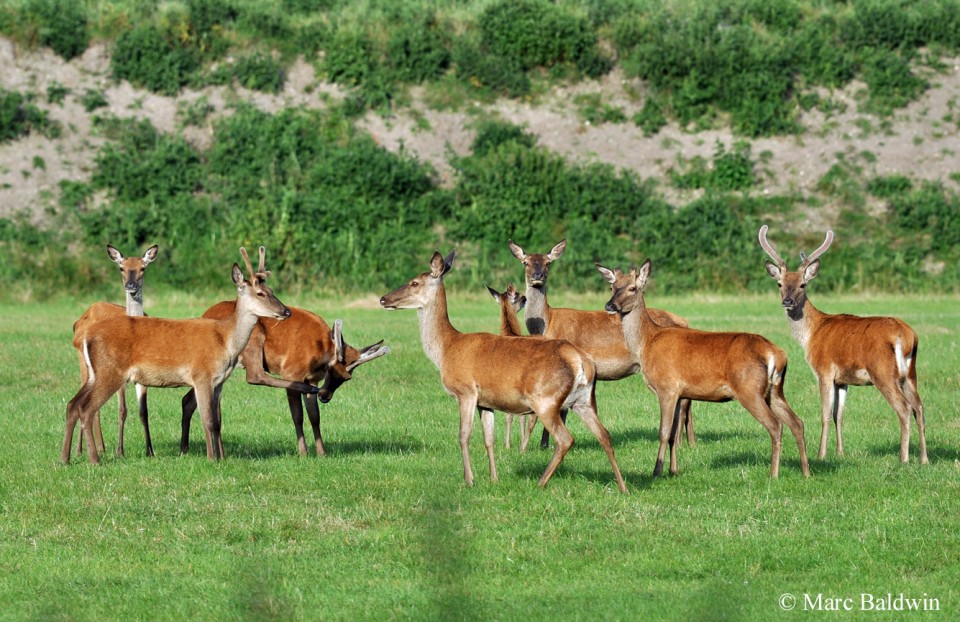
On Rum, the RDRG biologists have observed that daughters tend to associate less with their mother as they grow older and, by the time they reach four or five years old, they adopt their own range that often overlaps with their mother’s range. In their 1982 book, the Cambridge University researchers note that, on average, hinds more than three years old shared about 30% of their core areas with their mothers. Interestingly, the research on Rum has shown that the daughters of young mothers tend to associate more closely with the dam than do daughters of older mothers – it has been suggested that this may reflect that older hinds generally have more daughters than younger ones and the calf seeks companions of her sisters rather than her mother. Concomitantly, sisters are commonly seen in groups with aunts and nieces. Clutton-Brock and his colleagues sum up nicely the phenomenon of hind groups in their 1982 book, in which they write:
“Hinds tend to associate with their mothers and sisters more frequently than with animals that do not belong to the same matriline.”
Why should this be so? Why do animals associate more with their relatives than strangers? Well, generally among social animals, we see that relatives tend to be more tolerant of their own offspring than those of strangers and will allow family members to feed closer to them than they would a stranger (this may also be sex dependent; on Rum it has been shown that hinds tolerate other hinds at closer proximity than stags tolerate other stags). Similarly, it is now well-established for several species that a youngster is safer from predation or attack when near its parents or another family member, who are considerably more likely to intervene than a stranger.
I don’t want to go into too much detail about this, but the idea that by protecting your close relatives you’re also protecting, and thus aiding the survival of, some of your own genes is known as the ‘selfish gene theory’. I would direct any interested readers to the fascinating book, The Selfish Gene, by evolutionary biologist Richard Dawkins; Professor Dawkins explains the idea far better than I could hope to. It certainly seems that it is beneficial for a deer to associate with its relatives and observations from Rum have documented that orphans that aren’t adopted early in life are often subjected to aggression from the herd and typically hold a low status in the hierarchy.
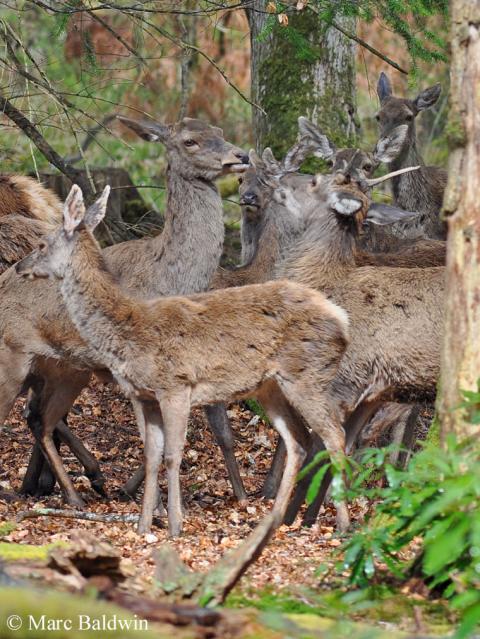
Het up hinds?
One might be tempted to think that life in a hind group might be more ‘relaxed’ than a stag group, but this doesn’t appear to be the case. We’ve already seen that stags fight with each other more often than hinds squabble, but hinds can still be aggressive. On Rum, matrilineal threats (where a hind threatens a close relative) were found to be less common than threats made to strangers and in their study of one population between 1977 and 1978, the RDRG observed that hinds between three and six years old received about seven matrilineal threats and 129 non-matrilineal threats (i.e. threats from strangers).
It appears that not only were matrilineal threats less common than other threats, they were also less intensive/aggressive. The most common threats were ‘nose and ear threats’, which involved jabbing the nose at the neck of another animal while exhaling loudly, and flattening the ears on the head while walking towards another animal, respectively. Hinds also kicked, bit and chased other hinds, generally in a bid to remove them from the immediate vicinity (presumably to have the feeding site to themselves), rather than drive them out of the area. Disputes were also settled by boxing, in the same way that antlerless or velvet stags were observed to fight. In their book, Clutton-Brock and his colleagues note that despite their appearance, the threats from hinds could lead to lasting injuries:
“Adult hinds not infrequently show the marks of kicks or bites on their flanks and ears, and a significant proportion of hinds shot in the annual cull had broken ribs.”
A study of the 560-or-so deer of the Val Trupchun valley in the Swiss National Park during 2003 yielded similar results to those presented for Rum. The data, collected by Nicole Bebie at the Universitat Zurich in Switzerland and Alan McElligott at the University of London, was published in the journal Mammalian Biology during 2008 and show that displacements, nose threats and kicking were the most common forms of aggression, with biting, ear threats and chases recorded less frequently. The zoologists also found that of the three social situations they studied -- i.e. females in oestrous and in a harem; hinds in a feeding group; and non-oestrous hinds in a harem -- the first two exhibited significantly more aggressive interactions than the third.
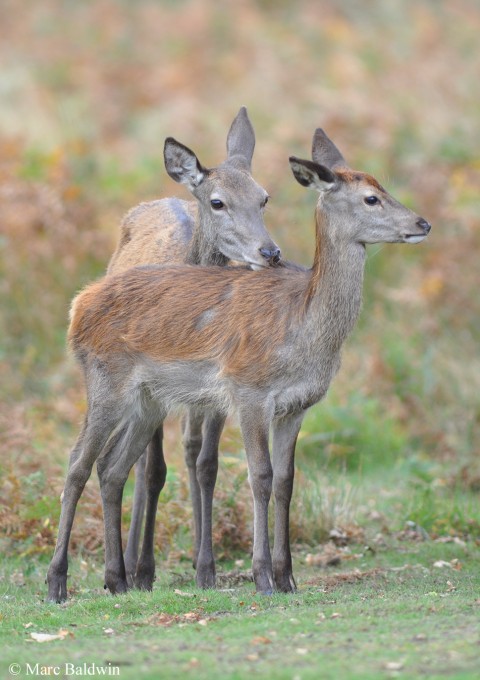
Interestingly though, the scientists didn’t observe any relationship with aggression levels and group size – ordinarily, one would expect that there would be more aggression in larger groups, but this doesn’t appear to be the case for these Swiss deer. Bebie and McElligott suggest that higher aggression in oestrous females might represent evidence of female competition for mates and that increased aggression in feeding groups could reflect a mixing of unrelated animals feeding together (while harems tend to be composed of related individuals). The latter of these seems to be supported by observations that family groups may merge in open areas while feeding, splitting up again upon returning to cover. Data from Rum add support for the initial conclusion of Bebie and McElligott and in their 1971 paper to the Journal of Reproduction and Fertility, Fiona Guinness, Gerald Lincoln and Roger Short note that:
“A hind’s position in the social hierarchy did not change at oestrus, but some became much more aggressive towards subordinates and demonstrative towards humans.”
Despite the above, some studies suggest that aggressive encounters are generally low among the hinds and, in his 1990 Animal Behaviour paper Chris Thouless notes that feeding competition among hinds was generally passive – that is, subordinates generally avoided dominant individuals, moving away if one approached. Indeed, Thouless found that the feeding rate, as measured by the number of bites of food taken, of a subordinate increased the further she was from dominant hinds, but was unaffected by how close she was to individuals of the same, or lower, rank.
In many mammalian societies, social bonds are reinforced by grooming. The rate of grooming between hinds of the same social group appears fairly low, although the RDRG document occasional observations of hinds grooming other hinds (always family members); licking and nibbling around the face, head, neck and ears. Grooming among stags is apparently extremely rare and although hinds have occasionally been seen to groom adult stags (i.e. those over two years old), this seems to be generally confined to the rut.
Communication
So, we’ve seen that deer are highly social mammals, forming mixed and single-sex groups depending upon the season; but how do the deer communicate with each other? Well, much of the communication between deer is scent-orientated.
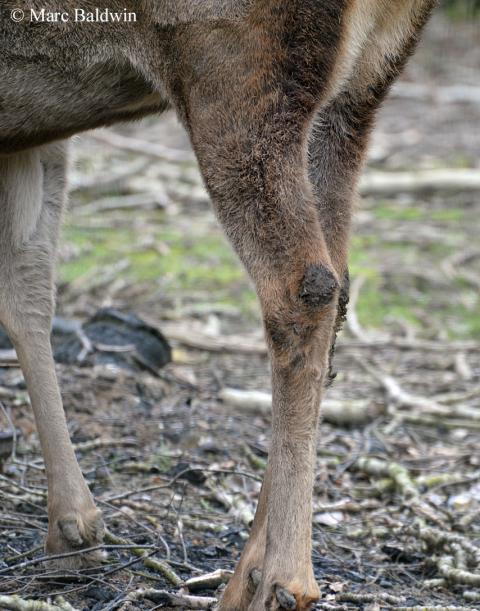
Smell ya later
In her 1991 book Deer, Norma Chapman notes that among the Cervidae (deer family) as a whole there are at least 13 sites on the body where a scent gland is known to be situated; although no single species is known to have all 13 glands, most have a combination of them, some of which are active all year around and others that are only active during certain seasons. The secretions of these glands come from specialised sweat and sebaceous glands within the skin, the latter of which produce fatty compounds – some of these secretions, as is the case for the tail gland of Red deer, take the form of a tar-like substance.
Red deer possess several of these skin glands that include those on their ankle or ‘hock’ (metatarsal glands), those on the inside of their back legs (tarsal glands), those between the cleaves of the hooves (interdigital glands), those on the underside of the tail (subcaudal gland); and that just in-front of the eye (the lachrymal, or pre-orbital, gland). In general, the scent produced by these glands may encode messages about the age and sex of the animal, and each deer may have its own distinct scent. The histology of the glands and the chemistry of their contents are outside the scope of this article, but I will try and summarise the basics.
Gerald Lincoln has demonstrated that the subcaudal and lachrymal glands of Red deer increase in size and activity during the rutting season, which ties in nicely with behavioural observations of stags in the wild that document them opening their lachrymal glands while roaring, parallel walking and fighting. Work by University of Trondheim (in Norway) researchers Jan Bakke and Erik Figenschou has uncovered details of the chemistry of some gland secretions as well as the urine chemistry – urine is often sprayed into wallows and scrapes as well as being released during rutting clashes.
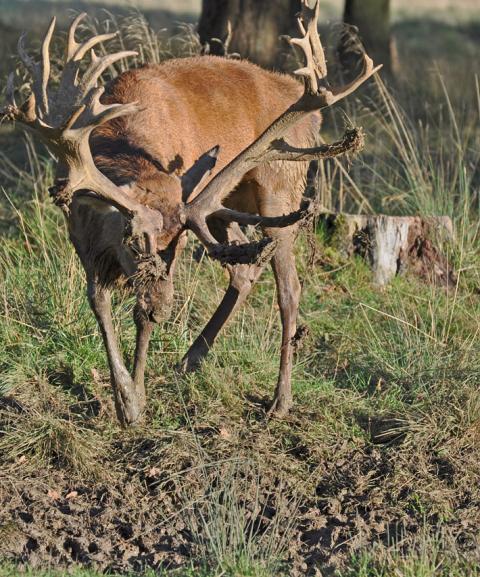
In a paper to the journal Comparative Biochemistry and Physiology during 1990, Bakke and Figenschou documented 70 volatile compounds from Red deer urine, the majority being carboxylic acids or their derivatives. It seems that, during the rutting season, the amounts of these compounds in the stag’s urine increase significantly, alluding to a change in the animal’s metabolism. In an earlier paper, to the Journal of Chemical Ecology, the same authors identified nine volatile components from the subcaudal gland of Red deer. In chemical terms, the more volatile a substance is the more prone it is to vaporizing and thus the better it is as a candidate for being odiforous. The components of the gland secretion can change according to season and the age of the animal.
Work by deer biologists Ruth Lawson, Rory Putman and Alan Fielding has shown that the lachrymal secretion of Red deer changes as the animal ages and, in their 2001 paper to the Journal of Zoology, suggested that some of the secretions from deer scent glands may carry “coded information about sex and possibly age as well as for the individual identity of the signaller”.
Red deer stags frequently partake in mud wallowing – a favoured wallow will generally be scraped with the feet and sprayed with urine before the stag commences wallowing. The wallows are generally two or three metres in diameter and emanate a strong musky smell. The heavily scented mud is then spread over the stag’s body. Wallowing behaviour is typically associated with the rut and it's thought the mud helps spread the stag's scent across his body and the dark colour makes him more intimidating to rivals. Stags will, nonetheless, wallow outside of the rut and hinds sometimes partake, although apparently less often than stags. Indeed, wallowing behaviour often coincides with the moult and the mud may help remove loose hair; it may also help cool the deer and provide some relief from biting insects during the summer.
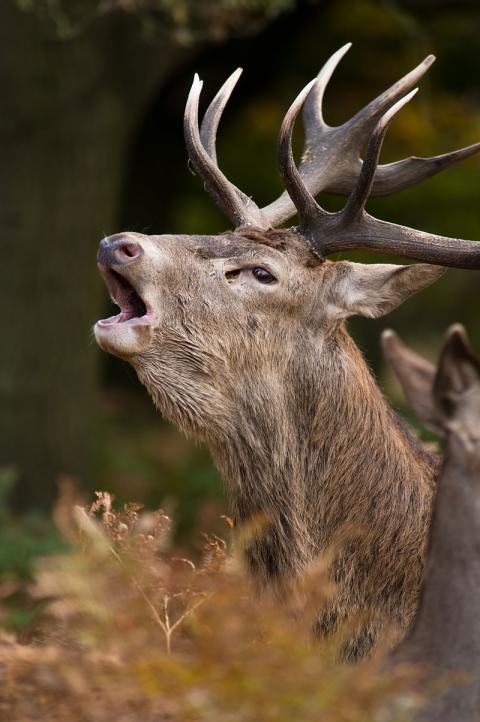
Scent is also an important component of mother-offspring communication and the pre-orbital gland seems to play a particularly important role. The pre-orbital gland sits in a depression, or tear-pit, just in front of each eye and is covered by a flap of skin under nervous control so the deer can open and close it. The scent gland produces a strong-smelling waxy substance that’s usually yellow in colour.
Some authors have suggested that the hind soon learns to distinguish the scent of her calf, even from some distance away, and if danger threatens, the calf will crouch down and close its scent gland – the hind can detect the cessation in scent from her calf, and will quickly return to it. Off-hand, this seems an odd strategy, because if a dam can detect the scent from a distance, surely the keen nose of a predator could too? Thus, it seems to make more sense that the gland should be opened to start an odour trail and alert the dam to a problem; new research suggests this may indeed be the case.
Studies by biologists at the Research Institute of Animal Production in the Czech Republic suggest that it is actually the opening of the pit that signifies stress and calves in their relaxed state typically have their glands closed. The scientists observed that when calves were manipulated by researchers (to mark them with an ear tag) all the animals opened their pre-orbital pit, whereas before they were caught (while they were lying in their enclosure), all but three calves had their glands closed. Previous studies by the same biologists have suggested that there are various other factors that affect whether the pre-orbital gland is open or closed, including whether they’re hungry or excited. Observations on the calves while suckling revealed that some (although not all) opened their glands when hungry and closed them when they’d drunk their fill.
A good listener
Sound is also important in Red deer society. Red stags are fairly quiet outside of the rut, but during the breeding season they may spend much of their time roaring – the stags produce a deep, loud, resonating roar/bellow, which is sometimes called “bolving”, especially in parts of southwest England (see QA on deer vocalisation currently in prep). Stags may also bark when alarmed, while hinds produce a sharp bark or high-pitched squeal when alarmed and may also produce a growling sound when anxious.
Both sexes are known to produce low grunts when approaching each other. I have already mentioned John Fletcher’s observation that hinds, under the influence of oestrogen close to parturition, can bellow like stags and there is at least one record to suggest they may do the same when scared or stressed. In a fascinating short communication to the Journal of Zoology in 1969, A. B. Cooper described an attack on a Red deer calf by a Golden eagle (Aquila chrysaetus) that he witnessed in July of the previous year. Cooper wrote of how the “howl” that the calf had given upon being struck by the bird had alerted a group of deer over the other side of the hill; these deer (a party of nine hinds) started to “low and bleat in an anxious manner” as they came looking for the calf. Cooper then wrote:
“The nine hinds kept up a constant lowing, similar to the bellowing of stags, and frequently gave the reedy bleats characteristic of milk hinds.”
Once the eagle had flown away, the hinds lowed for a few minutes before quieting down. Calves, when not being ambushed by a large bird of prey, tend to emit a softer ‘bleat’, which the hind responds to with a louder nasal bleat, not dissimilar to that produced by sheep. In their Mammals of the British Isles: Handbook, 4th Edition, Brian Staines, Jochen Langbein and Tim Burkitt describe a ‘low moo-ing’ that the hinds make when locating their calf.
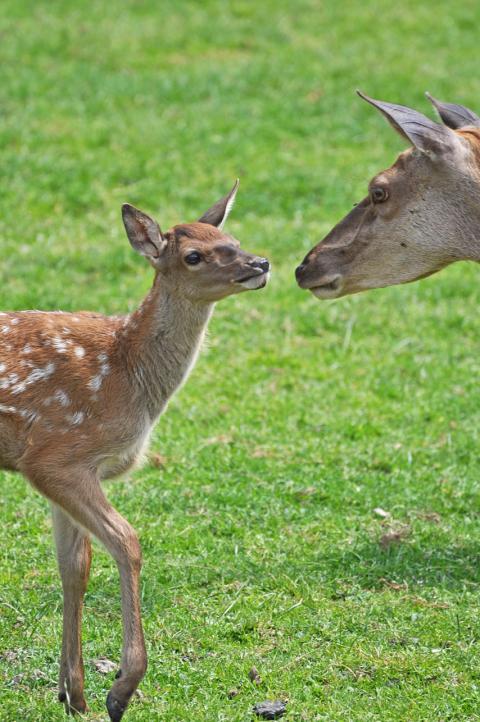
Dominika Vanková at the Research Institute of Animal Production in the Czech Republic and colleagues assessed the communication between Red deer hinds and their calves. Vanková and her team designed a playback experiment to test the recognition abilities of 11 hand-reared hinds and their calves. They found that vocalisation was the main method of communication between mother and calf, with hinds replying to calf calls more often than vice versa and responded to the calls of their own calves more often than "alien" youngsters. Interestingly, however, hinds still quite frequently responded to calls by these alien calves, more often than calves responded to calls from alien hinds.
This led the researchers to suggest calves were better at recognising their mother's voice than their mother was at recognising their voice. Hinds may therefore use vision and/or memory of approximate hiding place to locate their calf, as well as listening for it. Hinds often responded to calls of alien calves when they could not see their own and similar behaviour has been observed in places such as Richmond Park where ear-tagging a calf brings several hinds running to investigate. In their 1997 paper to Ethology, the researchers explained:
"The mother hinds reacted to the calfs distress call as well as to an imitation of this call, when they could not see their calves. As predicted, this type of vocalization probably serves more to inform the hinds about a situation than to identify the vocahzing animal."
Vanková and her colleagues found that there were only slight variations in the acoustic properties of two-day-old calf vocalisations, which may explain why hinds also need a visual cue. Individually appears to develop with age and the researchers noted that hinds could be identified quite well by the physical characteristics of their voice, while the calves could not.
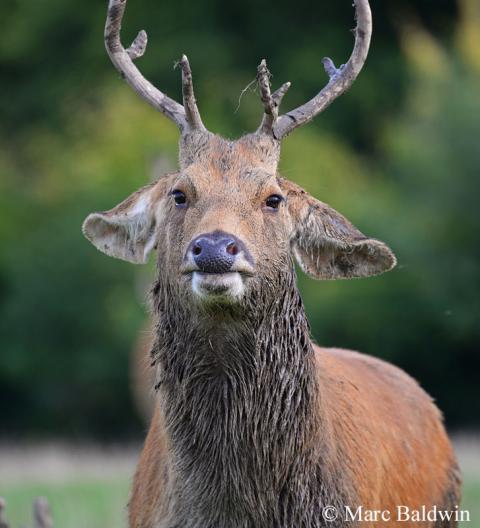
Body language
Many species of deer exhibit a "tail-flagging" behaviour, during which a deer erects its conspicuous pale tail when fleeing from a disturbance; it has been suggested this signals to a predator that it has been spotted, with the element of surprise lost, attack is futile. Red deer, however, have a pale cream-coloured rump patch that is less conspicuous than in other species. Indeed, I've never observed tail-flagging in this species, nor have I come across references to it in the literature, suggesting that if it does happen it is an uncommon behaviour. Calves and hinds will occasionally take on the stiff-legged bounce known as a "pronk" or "stott" when fleeing from disturbance; but, again, this seems uncommon and I've not observed stags to do it. Normally adults of both sexes simply run. I have, nonetheless, seen wapiti perform what is probably best described as a "strut" in front of wolves in Yellowstone National Park.
Both sexes will stamp their forefeet when disturbed and I have seen this particularly in hinds. Foot stamping is often accompanied by a short, sharp bark, which causes the rest of the herd to fix their vision immediately on the threat (implying some directional quantity in the bark). Ears flattened and pulled back and/or slightly out to the sides are an indication of unease or aggression.